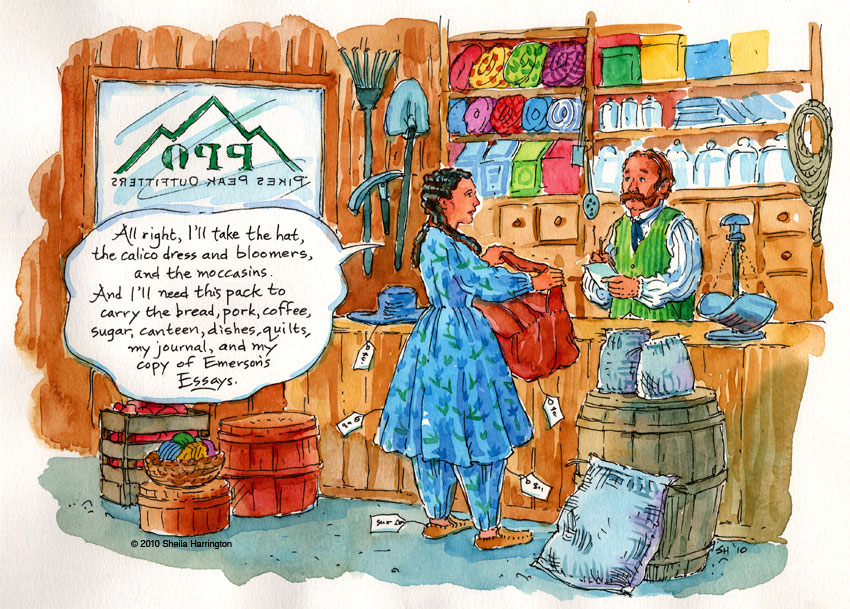Imagine that you are a little girl born in a village in North America in the early 19th century. You, like the other village girls and their mothers, help maintain a family farm: growing vegetables, cooking, scrubbing, making clothes. You might see your destiny as a farmer’s wife, raising children to follow in your footsteps.
But perhaps your mother is also an advocate for women’s suffrage, and your father is a fierce abolitionist, which might give you a somewhat different perspective on your life. This was the parentage of Julia Archibald (1838-1887), later Julia Archibald Holmes, born in the village of Noël, Nova Scotia, in 1838. And today, August 5th, is the anniversary of the day she became the first woman to reach the top of Pikes Peak, Colorado, when she was twenty years old.
When Julia was about ten, the family moved to Worcester, Massachusetts (where her mother became friends with Susan B. Anthony). But they didn’t stay there long. Slavery had been abolished in Canada in 1834, but there was a growing anti-slavery movement in the United States, and Kansas was the place in which the Archibalds decided to support it. They had a mission.
A series of treaties had declared Kansas to be Indian Territory, and a number of Native American tribes had been removed from their eastern lands and resettled there. Nevertheless, increasing numbers of westward-bound pioneers followed trails that passed through the territory, and by 1850 settlers were squatting along the trails and elsewhere in Kansas. Pressure from these land-hungry folks led eventually to (familiar story) the creation of new treaties, the removal of tribes to areas yet further west, and the passage of the Kansas-Nebraska Act in 1854, opening the area officially to settlement.
It was not only Native American tribes who were unhappy about this. Slave-state Southerners were displeased that the decision about the existence of slavery in the new territory was to be left to its residents. So, as you might guess, both advocates and opponents of slavery rushed into Kansas, each staking out territory and hastily setting up local provisional governments and institutions that were attacked by both sides, setting off several years of violence that foreshadowed the Civil War.
The Archibalds settled in Lawrence, Kansas, a center of controversy, and their house became a way station on the Underground Railroad. In Lawrence Julia met James Holmes, a veteran of John Brown’s campaigns. Apparently he was fiery and dedicated; she was handsome and spirited; there were certainly similarities of background. They were married in 1857.
But they didn’t stick around in Kansas for the resolution of the national conflict. The following year they joined a wagon train headed for Colorado, where gold had been discovered. And a lot of other excited Kansans were doing the same thing. Not many gold-seekers actually found what they sought, but their immigration resulted in the founding in Colorado of towns, businesses, churches, and probably plenty of saloons, as well as a rapid dramatic increase in its population.
According to Julia’s journal, their own party was driven more by “a desire to cross the plains and behold the great mountain chain of Noth America” than to search for gold. She acquired what she deemed a sensible traveling outfit: hat, moccasins, short calico dress, and bloomers. Bloomers had been recently introduced to the public by women’s suffragists as more sensible than skirts.
Her choice of clothing gave Julia the freedom to walk beside the covered wagons instead of riding. She improved her stamina by deliberately increasing her daily distance, and she recorded her observations of wildflowers, landscape, and skies in her journal. The only other woman on the trip disapproved of Julia’s unconventional garb and stayed in her wagon, thus missing most of the scenery. (Like my children, with noses in their books when we travel. “Look! Look out the window!”)
To Be Continued—Please see August 6/Mountain Woman Part 2

